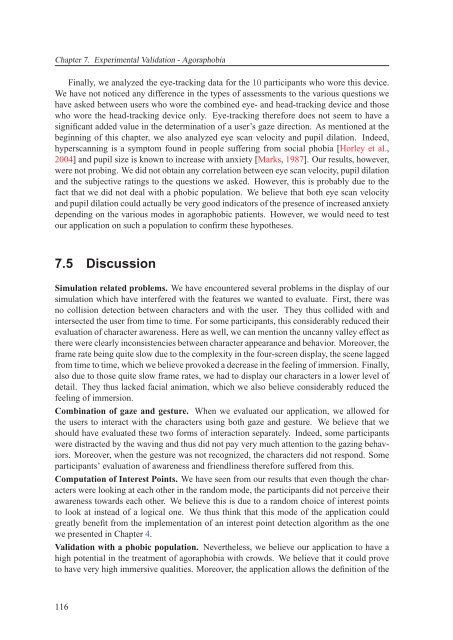Texte intégral / Full text (pdf, 20 MiB) - Infoscience - EPFL
Texte intégral / Full text (pdf, 20 MiB) - Infoscience - EPFL
Texte intégral / Full text (pdf, 20 MiB) - Infoscience - EPFL
You also want an ePaper? Increase the reach of your titles
YUMPU automatically turns print PDFs into web optimized ePapers that Google loves.
Chapter 7. Experimental Validation - Agoraphobia<br />
Finally, we analyzed the eye-tracking data for the 10 participants who wore this device.<br />
We have not noticed any difference in the types of assessments to the various questions we<br />
have asked between users who wore the combined eye- and head-tracking device and those<br />
who wore the head-tracking device only. Eye-tracking therefore does not seem to have a<br />
significant added value in the determination of a user’s gaze direction. As mentioned at the<br />
beginning of this chapter, we also analyzed eye scan velocity and pupil dilation. Indeed,<br />
hyperscanning is a symptom found in people suffering from social phobia [Horley et al.,<br />
<strong>20</strong>04] and pupil size is known to increase with anxiety [Marks, 1987]. Our results, however,<br />
were not probing. We did not obtain any correlation between eye scan velocity, pupil dilation<br />
and the subjective ratings to the questions we asked. However, this is probably due to the<br />
fact that we did not deal with a phobic population. We believe that both eye scan velocity<br />
and pupil dilation could actually be very good indicators of the presence of increased anxiety<br />
depending on the various modes in agoraphobic patients. However, we would need to test<br />
our application on such a population to confirm these hypotheses.<br />
7.5 Discussion<br />
Simulation related problems. We have encountered several problems in the display of our<br />
simulation which have interfered with the features we wanted to evaluate. First, there was<br />
no collision detection between characters and with the user. They thus collided with and<br />
intersected the user from time to time. For some participants, this considerably reduced their<br />
evaluation of character awareness. Here as well, we can mention the uncanny valley effect as<br />
there were clearly inconsistencies between character appearance and behavior. Moreover, the<br />
frame rate being quite slow due to the complexity in the four-screen display, the scene lagged<br />
from time to time, which we believe provoked a decrease in the feeling of immersion. Finally,<br />
also due to those quite slow frame rates, we had to display our characters in a lower level of<br />
detail. They thus lacked facial animation, which we also believe considerably reduced the<br />
feeling of immersion.<br />
Combination of gaze and gesture. When we evaluated our application, we allowed for<br />
the users to interact with the characters using both gaze and gesture. We believe that we<br />
should have evaluated these two forms of interaction separately. Indeed, some participants<br />
were distracted by the waving and thus did not pay very much attention to the gazing behaviors.<br />
Moreover, when the gesture was not recognized, the characters did not respond. Some<br />
participants’ evaluation of awareness and friendliness therefore suffered from this.<br />
Computation of Interest Points. We have seen from our results that even though the characters<br />
were looking at each other in the random mode, the participants did not perceive their<br />
awareness towards each other. We believe this is due to a random choice of interest points<br />
to look at instead of a logical one. We thus think that this mode of the application could<br />
greatly benefit from the implementation of an interest point detection algorithm as the one<br />
we presented in Chapter 4.<br />
Validation with a phobic population. Nevertheless, we believe our application to have a<br />
high potential in the treatment of agoraphobia with crowds. We believe that it could prove<br />
to have very high immersive qualities. Moreover, the application allows the definition of the<br />
116

















